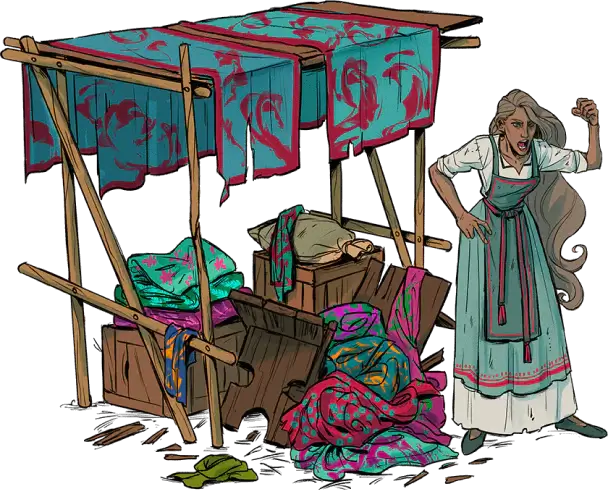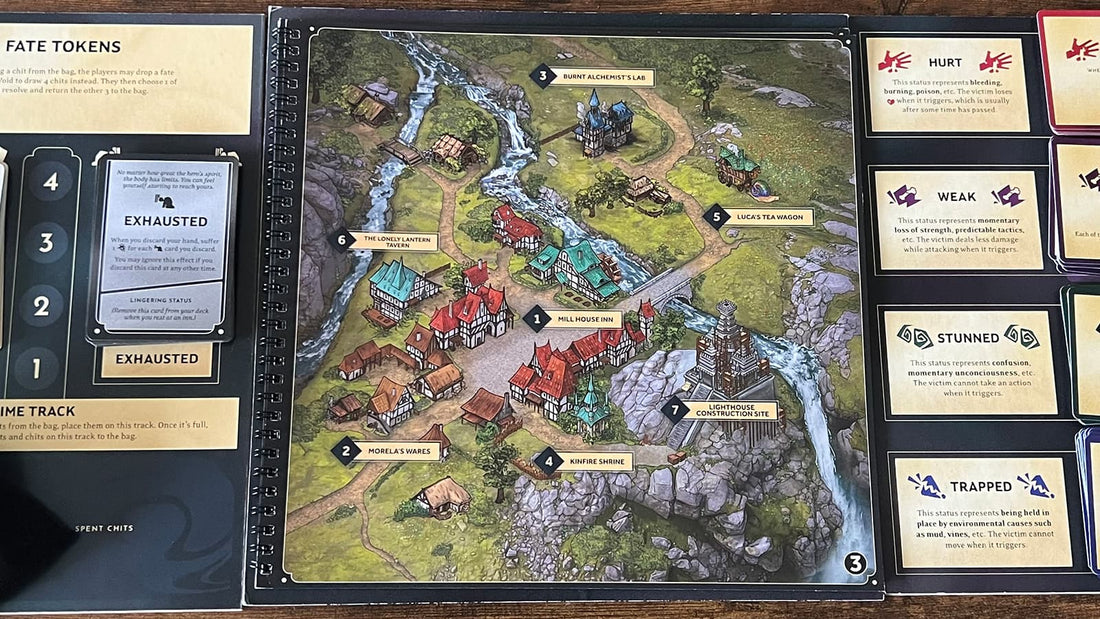It’s the last week of our Kinfire Focus series! We’ve selected our characters, learned about combat, and adventured our way through some quests. Now it’s time to be rewarded by visiting a town, talking to some NPCs, finding some quests, and leveling up our character decks.

City Exploration
Once you reach the first city, each time you complete a quest, you and your companions will be given a number of “city actions” in order to explore your current town. To use a city action, look at the city map and choose a numbered location that you wish to visit as a group, then look in that city’s deck of cards for the matching numbered card and read it.

Vinna: affectionately called "Tutorial Town" by the Incredible Dream team
Locations in cities can lead to new quests, shops, NPCs, items, and more. If for some reason the location’s card isn’t in the deck, it means you can’t visit it yet. You’ll need to select a different location, but don’t worry, your city action isn’t used up.
Each town you visit will have an Inn, and this is where you’ll go to rest, remove Exhausted cards from your deck, and do some deckbuilding.
Deckbuilding
Deckbuilding is a core component of Kinfire Chronicles, and allows you the opportunity to truly customize your Seeker to your playstyle. By completing certain quests or shopping at certain stores, you can acquire additional cards that you can trade into your deck. You can only customize your deck when you rest at an inn, or when the game provides you with a unique opportunity. Here’s how it works:
You will always have a core deck of 18 cards: 9 action cards and their 9 corresponding boost cards. When you swap out cards, you must swap out both the action and matching boost card. When you do, the cards you give up will go into a community pool, where other Seekers can swap them into their own deck. This can lead to moments where a ranged character like Valora can get her hands on some melee actions, or even cards that encourage her to draw enemy focus (we saw it happen in one of our playtests). This allows you to customize your Seeker to play exactly the way you want them to.
Throughout the game you might find yourself with some “disposable” cards such as Sweet Balm (for healing), but those will directly say that they don’t count towards your hand limit. When choosing your 9 matching card sets, there are a few conditions you’ll need to adhere to.
Action cards must match your character sheet
If you look at your Seeker’s character sheet, you’ll see a line in the middle with 9 colors. These correspond to your Seeker’s deck make-up. Your 9 action cards must match this make-up (the boost cards don't, since sometimes they're not the same color as their action card). So for example, Roland’s sheet has 4 blue, 3 red, and 2 green, so his action cards must also have 4 blue, 3 red, and 2 green. The good news is that cards with multiple colors, like red/green, can count as either color when deckbuilding (but not both). White cards (and later, the colorless Void cards) can count for any color you want.

Roland's Seeker sheet, showing he needs to have 4 blue action cards, 3 red actions, and 2 green

In Roland's starting deck, you can see Meteor Throw is used as a red card, and Hammer and Tongs is used as a green card
If an action card has a Seeker’s face, only that Seeker can use it
This one is pretty self explanatory. Each Seeker has special skills that make them unique and valuable members of the team. If a card shows a Seeker’s face on it, it’s unique to that Seeker, and no other Seeker may add it to their deck.

Even the flavor text makes it clear these cards can only be used by these characters
You must have enough Kinfire to use the cards
As you progress and earn new cards, you’ll see that some of them have Kinfire symbols in the bottom right corner. You can only add these cards to your deck if you have enough kinfire tokens. For example, if I want to add three different cards with 1 kinfire in the corner, I’ll need 3 kinfire tokens. If you don’t have enough, you can’t add that card to your deck. You’ll need to earn more kinfire by getting your way in conundrums, or reaching certain story beats. While it’s rare, you can lose kinfire, and if that takes you below the threshold for your deck, you must make sure that your Seeker deck is within its kinfire limit before embarking on your next quest.

The "Loyal Arrow" card requires 1 kinfire to use
Maximum of 3 Instant cards
Instant cards are particularly powerful because they don’t use up a Seeker’s action. Usually they say “free action,” but others are conditional, such as Asha’s starting card Scorpion Strike. Because stacking these could lead to an endless loop, there is a limit of 3 Instant cards in your deck.

Instant cards also have a lightning symbol in the corner
The great thing about deckbuilding at the Inn is that you usually need to stop to rest and get rid of Exhaustion cards anyway, so that's the perfect opportunity to try a new build. And don't forget about those boost cards! Sometimes the action card isn't necessarily better, but its matching boost could come in handy.
—
Now that you know how the game works, you can try out the first two quests and check out the town of Vinna in our Tabletopia demo. Or, you can watch two groups of tabletop personalities try out the first few quests in the Kinfire Playthrough series



